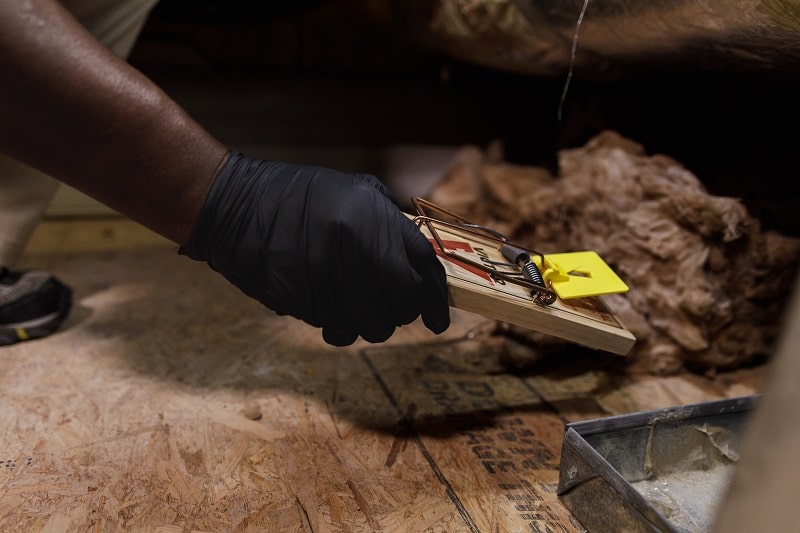Mouse Removal in Durham, NC
Do you need to get rid of mice?
Call Trutech In to Get Mice Out
Some Geographic Restrictions

Pest Control for Mice Infestation
If you’re dealing with a mouse problem in Durham in your home or business, it’s important to act quickly to get the situation under control. Mice can spread diseases, contaminate food, and cause significant property damage if left unchecked.
Catching these signs early is key to addressing a mouse problem before it gets out of hand.
Mice are not only the most common pest animal in the United States, but also some of the most destructive. Rodents cause property damage, spread diseases, and contaminate your food.
Let Trutech in to get mice out. Our mouse control program includes rodent traps, bait stations, whole home exclusions, remediation, and on-going pest control to keep rodents out of your house.
Professional Mouse Control

Mouse Traps
Proper placement of trap is essential for effective rodent control. Trap placement depends on what rodent species, how many rodents, how long the infestation has lasted, and what the condition of the property. A few traps haphazardly placed is not an effective means for control.

Exclusion & Control
Once the population is controlled inside the house, exclusions keep them out. Mice can squeeze through a dime sized size hole. Seal cracks and openings in building foundations and any openings for water pipes, electric wires, sewer pipes, drain spouts, and vents. Rats cam gnaw away materials like wood, caulk, plastic, and aluminum.

Monitoring and Maintenance
Mice contaminate your home. We apply sanitization agents to disinfect the areas with mouse activity. We can repair and replace insulation. Ectoparasites like mites, lice, ticks, and fleas are all found on mice. Ectoparasite agents exterminate those pests. Our rodent maintenance program uses bait stations outside your house to manage mouse populations on your property.
Mice Problems

Common Signs a Mouse Infestation
Droppings – Small, dark pellets of mouse feces are a clear indicator of an active infestation. Look for them along baseboards, in cabinets, or near food sources.
Gnaw marks – Mice have constantly growing teeth, so they need to gnaw on hard surfaces to keep them trimmed. You may notice teeth marks on wood, wires, or food packaging.
Nesting materials – Mice will shred paper, insulation, or fabrics to build their nests, often in hidden areas like attics or wall voids.
Tracks and rub marks – Mice leave tiny footprints and grease marks as they travel along the same paths repeatedly.
Noises – You may hear scurrying, squeaking, or gnawing sounds, especially at night when mice are most active.
Unpleasant Odors: The strong, musky odor of mice and their droppings can permeate your home, making it an unpleasant living environment.
Damage – Mice can chew through drywall, insulation, and wiring, causing structural and electrical issues over time.

Dangers of Mouse Infestation
As the leading wildlife management experts at Trutech Wildlife Service, we understand the significant impact a mouse infestation can have on homeowners. Mice are not only a nuisance, but they can also cause extensive damage to your property and pose serious health risks.
Some of the common damages a mouse infestation can cause include:
Structural Damage: Mice have sharp teeth and will chew through drywall, insulation, wood, and even electrical wiring, leading to costly repairs and potential fire hazards.
Contamination: Mice can spread diseases, such as hantavirus, salmonella, and leptospirosis, through their droppings, urine, and nesting materials, putting your family’s health at risk.
Food Contamination: Mice will infest your pantry, chewing through food packaging and leaving behind their droppings, rendering your food supplies unsafe for consumption.
Some Geographic Restrictions
Frequently Asked Questions
Mouse bites can cause hantavirus, a serious respiratory ailment that can be fatal. This illness may also come from inhaling dust from old mouse droppings. Another disease that results from a mouse bite, rat-bite fever often leads to flu-like symptoms and a rash.
Leptospirosis is another flu-like illness carried in bacteria found in mouse urine. This bacteria can stay alive in water and soil for months. Without treatment, afflicted people are at risk for permanent kidney and liver damage, breathing problems, and even death. Other mice diseases include:
- Plague, a disease passed to humans bitten by fleas from infected mice
- Babesiosis, an illness spread by mouse ticks, which can be fatal for children and the elderly
- Salmonellosis, a bacterial infection that comes from foods contaminated by mouse waste
Sharing a residence with mice and other rodents can result in both costly damage and illness. At the first sign of their presence, homeowners should call Trutech for professional removal.
Without entering attics to conduct periodic inspections, homeowners may not detect mouse infestations until it is too late. The rodents breed rapidly and can cause widespread structural damage, as well as contaminate houses with feces and urine. By paying attention to the sounds and smells around the house, in addition to keeping an eye open for adult mice scampering around, residents can identify mice in the attic without having to climb up for a visual inspection. Hearing scratching, scuttling, or squeaking sounds coming from the attic strongly indicates the presence of as infestation. These sounds will be more prevalent at night when the animals are most active. Additionally, the pungent smell of feces and urine will pervade the top level of a house if mice are living in the attic.
Homeowners can deter the presence of mice in backyards by keeping a vigilant eye open for signs of mouse activity and then eradicating infestations as soon as they appear. As rodents dig up newly planted seeds and young plants from gardens and flowerbeds, property owners should regularly check these areas for signs of destruction. Mouse nests, which look like balls of grass and shredded plant fibers, may be found among the roots of shrubs, under piles of branches, or within secluded spaces like hollow logs and unused sheds. Since the presence of mice in backyards drastically heightens the possibility of indoor infestations, homeowners should take immediate action against outdoor populations.
Mice are mainly nocturnal but can be active during the day as well. Aside from seeing mice scurry about the house, homeowners can identify the presence of mouse infestations by looking for the other telltale signs the rodents leave behind. These may include droppings, greasy smudge marks, urine, and holes gnawed in walls and food containers. A single mouse can produce over 50 pellet-shaped droppings in a day, depositing them around their food sources and near their nests. Their oily, dirty fur also leaves greasy smudges when they rub up against walls. Deposits of urine often accumulate around mounds of dirt and grease. Mouse holes can be identified by tiny tooth marks and collections of wood chips where small cracks in baseboards, walls, or window frames have been enlarged. Mice also excretea musky smell that can clue homeowners in to their presence.
Getting rid of house mice can be daunting for inexperienced homeowners. There are many commercially available traps and baits, but the creatures reproduce so rapidly and pose such a great hazard to human health that their expedient removal should be entrusted to a pest control company. Mice are capable of spreading diseases like leptospirosis, meningitis, tularemia, and salmonellosis by contaminating food and letting their excrement accrue around the house. Trutech employs teams of highly skilled animal removal technicians who are equipped with the knowledge and tools necessary to eliminate house mice and safeguard homes against the threats they create.
Sounds and smells are helpful in determining if there are mice in the walls. Scurrying and scratching sounds will be common during the night. Homeowners may also hear squeaking coming from wall cavities. As a single mouse produces 50 to 75 droppings a day, excrement will quickly accumulate given an infestation. It won’t be long before the smell pervades the building. Additionally, mice give off a characteristic musky odor that helps with the detection of mice in walls. Finally, as their fur is greasy and dirty, mice often leave marks on wall exteriors as they scamper alongside floorboards.
The most proven methods for deterring mice without chemicals include proper sanitation and rodent-proof construction. Proper sanitation practices extend beyond simply sweeping floors, including:
- Reducing available shelter both inside and outside the home
- Keeping woodpiles away from foundations and off the ground
- Removing or modifying birdfeeders
- Securing food and pet food in airtight containers
Mice are able to survive with limited food, shelter, and water. This is why sanitation efforts must be combined with exclusion tactics to successfully deter them from homes. Use mouse deterrents like the following:
- Make sure doors, windows, and screens fit tightly.
- Use a combination of steel wool and caulking to eliminate any openings.
- Install door sweeps.
One misconception we often come across is when homeowners set their own traps, catch a mouse or two, and think the problem is resolved. Unfortunately, this is usually far from the truth. Mice are often neophobic and can be cautious of traps, especially after a few have been caught.
Being at the bottom of the food chain also requires mice to breed at a very high rate. One female is able to produce an average litter of 5-8 young every 20-25 days. She is actually able to become pregnant again just hours after giving birth to a litter.
Given that mice become mature at around 6 weeks and can then start having litters of their own, you can see how this problem could get out of hand very quickly.
To keep mice out of air ducts, Trutech technicians use knowledge from their educational background and extensive training to determine the best areas to concentrate treatment of your home.
This begins with a complete “top to bottom, inside and out” inspection of the home. We want to know where the mice have been, what areas are currently experiencing the most activity, and what may be attracting them to these areas.


